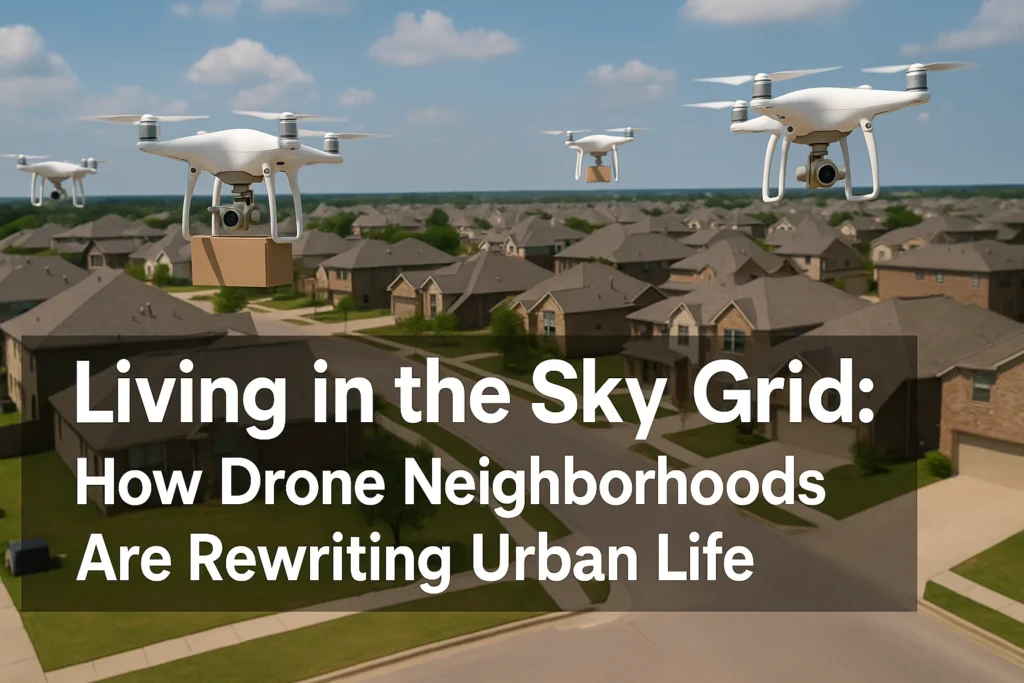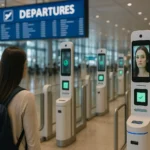Introduction: Your Next Delivery Might Fly In
Imagine a world where the familiar rumble of a delivery truck is replaced by the quiet hum of a drone, where packages float down from the sky directly to your backyard, and where urban skies are as organized as our roads. For residents in pioneering communities in Texas and Dubai, this vision is no longer a futuristic fantasy but an unfolding reality. These areas are becoming the world’s first “drone-first” neighborhoods, designed and optimized not just for ground-based living but for seamless aerial delivery and, in some cases, advanced urban services.
It’s a subtle but profound shift. These aren’t isolated bubbles where drones are the only way to interact with the outside world, but rather vibrant communities where aerial operations are integrated into the daily fabric of life, often taking priority in planning and infrastructure. This transformation is rewriting the rules of urban convenience, redefining logistics, and opening up a new dimension in how cities function. Let’s explore how these trailblazing drone neighborhoods are shaping the urban future.
The Promise of the Air Lanes: What “Drone-First” Truly Means
When we talk about “drone-first” neighborhoods, it’s easy to picture a sci-fi landscape. The reality, for now, is more grounded but no less revolutionary. These communities aren’t eliminating cars or human interactions; instead, they are prioritizing and optimizing their design and regulations to leverage drone technology for various services.
At its core, a drone-first neighborhood means:
- Optimized for Aerial Delivery: The community’s layout, landing zones, and possibly even home designs are conducive to receiving packages via drone. This can include designated delivery pads, automated receiving boxes, or clear flight paths that avoid obstacles.
- Integrated Airspace Management: Instead of drones being an afterthought, the low-altitude airspace above these neighborhoods is meticulously planned and managed to accommodate a high volume of autonomous aerial traffic safely. This involves sophisticated Unmanned Traffic Management (UTM) systems, akin to air traffic control for drones.
- Priority for Aerial Services: While traditional deliveries still exist, drone delivery often becomes the preferred, fastest, and most common method for small packages, food, and even essential medical supplies.
- Enabling Future Urban Air Mobility: These neighborhoods often serve as testbeds or early adopters for broader Urban Air Mobility (UAM) concepts, including potential future passenger-carrying “flying taxis.”
The goal is to move congestion from the ground to the sky, offering unparalleled speed, convenience, and potentially a more sustainable way to move goods and eventually people within urban areas.
Texas Takes Flight: Where Drones Deliver Your Daily Needs
In the vast landscape of Texas, particularly within the Dallas-Fort Worth (DFW) metroplex, “drone-first” is steadily becoming a reality for thousands of residents. Companies like Wing (an Alphabet/Google subsidiary) and Flytrex have established significant commercial drone delivery operations, essentially turning suburban neighborhoods into functional “sky grids.”
In communities such as Frisco and Little Elm, residents can now order everything from groceries and hot meals to over-the-counter medicines, with delivery drones arriving in minutes. These are not experimental, one-off flights; they are sustained, daily operations that have completed hundreds of thousands of deliveries.
Here’s how it often works:
- App-Based Ordering: Customers use a dedicated app to place orders from participating local businesses (restaurants, pharmacies, convenience stores).
- Automated Loading: At a local “nest” or small distribution hub, an automated system loads the ordered items onto a drone.
- Precision Delivery: The drone flies autonomously along pre-determined, optimized routes, navigating using advanced AI-powered vision systems, LiDAR, and high-precision GPS. Upon arrival, it hovers over the designated delivery spot (often a small landing pad or even a backyard) and gently lowers the package via a winch system. The drone doesn’t need to land, ensuring safety and efficiency.
A key enabler in Texas is the active collaboration between these drone operators on Unmanned Traffic Management (UTM). Flytrex and Wing are working together to automate the separation of their commercial drone flights in shared low-altitude airspace. This “air traffic control for drones” is crucial for scaling operations, ensuring safety when multiple drones from different companies are flying in close proximity. This cooperative approach is setting a precedent for how future crowded urban airspaces will be managed, turning these Texas suburbs into a living laboratory for the future of logistics.
Dubai’s Vertical Vision: From Parcels to “Flying Taxis”
Across the globe, Dubai is pushing the boundaries of urban innovation with its ambitious “Smart Mobility Vision 2030,” where drones play a central role in transforming the city’s infrastructure and services. While its “drone-first” initiatives are often embedded within existing or newly planned smart city districts, the scale and intent are monumental.
One notable example is the pilot phase for drone delivery that has commenced in Dubai Silicon Oasis (DSO). Here, a subsidiary of the Chinese tech giant Meituan, Keeta Drone, received an operational license from the Dubai Civil Aviation Authority (DCAA) to deliver food and medicine. This project aims to demonstrate the feasibility and benefits of aerial last-mile logistics within a high-tech urban environment. The plan is for drone delivery services to eventually cover a significant portion—33%—of Dubai by 2030.
But Dubai’s vision extends far beyond just package delivery. The city is a global leader in advancing Urban Air Mobility (UAM), which includes future passenger-carrying vehicles. Dubai is actively planning for the introduction of eVTOLs (electric Vertical Take-Off and Landing aircraft), often dubbed “flying cars,” with the ambitious goal of having air taxi services operational by 2025-2026. This involves:
- Vertiport Development: Establishing dedicated “vertiports” – small, urban airports for eVTOLs – in key areas like Palm Jumeirah, Downtown Dubai, and Dubai Marina.
- Regulatory Framework: The DCAA is actively developing the necessary regulations and certifications for these advanced aerial vehicles.
- Strategic Partnerships: Collaborating with leading UAM companies like Archer and Joby to bring their flying taxi services to the emirate.
While not “drone-only” in the traditional sense, Dubai’s strategy is to integrate drones and larger aerial vehicles into the very fabric of its urban planning, creating a multi-layered transportation system where the sky is increasingly part of the grid, not just for deliveries but for personal mobility as well.
Building the Sky Infrastructure: Beyond Just the Drone
A drone-first neighborhood isn’t just about the drones themselves; it’s about the sophisticated, often unseen, infrastructure that supports their seamless operation. This ground-based network is as crucial as the aerial vehicles themselves.
- Unmanned Traffic Management (UTM) Systems: This is the equivalent of air traffic control for drones operating at low altitudes. Advanced software platforms manage drone flight paths, prevent collisions, track vehicle positions in real-time, and handle contingencies. These systems are essential for scaling operations and integrating multiple drone operators in shared airspace, ensuring safety and order in the “sky grid.”
- Automated Charging Stations (Drones): Drones have limited battery life. To ensure continuous operation, networks of automated charging stations are being deployed. These “drone docks” allow drones to land, recharge their batteries (sometimes through robotic battery swaps), and quickly return to service, often without human intervention. Some are even exploring solar-powered charging options for sustainability.
- Micro-Fulfillment Centers and Hubs: To enable rapid delivery, drone operations rely on strategically placed, smaller fulfillment centers within or very close to neighborhoods. These hubs store inventory, process orders, and serve as the drone’s “nest” for launch and landing.
- Delivery Landing Zones: Residents in drone-friendly neighborhoods might have designated landing pads in their yards, on rooftops, or community-shared drop-off points. These zones ensure safe and precise package delivery away from obstacles and people.
- Weather and Environmental Monitoring: Real-time localized weather data (wind speed, precipitation, temperature) is critical for safe drone operations. Drones themselves often carry sensors to provide this data, feeding into the UTM system to dynamically adjust flight plans or pause operations when conditions are unsafe.
This complex interplay of hardware, software, and physical infrastructure creates the robust backbone required for drone-first urban living, ensuring reliability and scalability.
Navigating the Urban Air: Safety and Autonomous Flight
The idea of autonomous vehicles flying overhead naturally brings up questions of safety. The success of drone-first neighborhoods hinges on ironclad safety protocols and advanced technology that allows drones to operate reliably in complex urban environments.
- Sense-and-Avoid Technology: Modern delivery drones are equipped with sophisticated sensor suites, including LiDAR (Light Detection and Ranging), high-resolution cameras, radar, and ultrasonic sensors. Coupled with AI-powered computer vision and machine learning algorithms, these systems enable drones to:
- Detect and identify obstacles (buildings, trees, power lines, other aircraft, birds).
- Dynamically reroute to avoid collisions in real time.
- Navigate in GPS-denied areas (like urban canyons between tall buildings).
- Redundancy and Fail-Safes: Drones are designed with multiple redundancies in their propulsion, navigation, and control systems. In the event of a component failure, backup systems are in place to ensure a safe landing or return to base. Automated emergency protocols also guide drones to predetermined safe landing zones if critical issues arise.
- Regulatory Frameworks: Governments and aviation authorities are actively developing and refining regulations to govern drone operations in urban airspace. In the US, the FAA (Federal Aviation Administration) sets rules for commercial drone operations, constantly evolving them to enable more complex maneuvers like Beyond Visual Line of Sight (BVLOS) flights. In Dubai, the DCAA (Dubai Civil Aviation Authority) is leading the charge in creating comprehensive regulatory frameworks for both drone delivery and future eVTOLs. These regulations cover pilot certification, drone airworthiness, operational procedures, and airspace integration.
- Data Security and Privacy: Protecting the data collected by drones (especially those with cameras) is a critical safety and privacy concern. Secure data transmission, encryption, and strict access controls are vital to prevent unauthorized access or misuse of information.
Through continuous technological advancement and stringent regulatory oversight, drone operations are being engineered to be as safe, if not safer, than traditional ground-based logistics.
The New Neighbors: Privacy, Noise, and Public Acceptance
While the benefits of drone-first neighborhoods are compelling, integrating a new aerial dimension into daily life introduces significant societal considerations that must be carefully managed.
- Privacy Concerns: Drones are equipped with cameras for navigation and safety. This raises immediate questions about individual privacy. Residents might feel uneasy about drones flying over their private property, even if the cameras are ostensibly not recording identifiable data or are only activated during the delivery drop-off. Building public trust requires transparent policies, strict data governance, and clear communication about what data is collected, how it’s used, and who has access to it. Some drone systems are designed with privacy-preserving algorithms that blur or omit sensitive details.
- Noise Pollution: Even with quieter electric motors, a constant hum from numerous drones could become a source of annoyance, particularly in dense urban environments. While a single drone might not be disruptive, a “sky grid” with frequent flights could contribute to ambient noise. Drone manufacturers are investing heavily in noise reduction technologies, and flight paths are often designed to minimize impact on residential areas.
- Public Acceptance: For drone-first neighborhoods to truly thrive, residents must embrace the concept. This acceptance often comes from direct experience with the convenience and reliability of drone services, coupled with reassurance about safety, privacy, and noise levels. Community engagement, pilot programs, and addressing concerns proactively are key to fostering a positive perception.
- Visual Intrusion: Beyond noise, the sheer visual presence of drones flying overhead could feel intrusive to some, altering the perception of their “personal airspace.” Urban planners need to consider the aesthetic impact and design communities that harmoniously integrate this new dimension.
These social challenges are as important as the technological ones. Successful drone-first neighborhoods will be those that not only leverage cutting-edge technology but also thoughtfully address and mitigate the concerns of the people living within them.
From Smart Home to Smart Sky: Enhancing Urban Life
Despite the hurdles, the advantages offered by drone-first neighborhoods are significant, promising to enhance urban living in myriad ways.
- Unparalleled Convenience and Speed: Imagine needing an ingredient for dinner, a forgotten item for school, or a prescription. With drone delivery, these items can arrive in minutes, bypassing traffic congestion and offering “on-demand” access to goods and services like never before. This transforms the “last-mile” of delivery from a bottleneck into a hyper-efficient process.
- Reduced Road Congestion and Emissions: Shifting a significant portion of last-mile deliveries from ground vehicles to electric drones can dramatically reduce the number of delivery vans and trucks on urban roads. This translates to less traffic, quieter streets, and a substantial decrease in carbon emissions and local air pollution, contributing to cleaner, greener cities.
- Increased Accessibility: Drones can reach locations that are difficult or time-consuming for traditional vehicles, whether due to traffic, geographical barriers, or remote access. This can be particularly impactful for delivering essential goods to underserved communities or during emergencies.
- Enhanced Safety (Roads): Fewer delivery vehicles on the road mean fewer road accidents involving these vehicles, contributing to overall road safety for pedestrians and other drivers.
- Economic Opportunities: The drone delivery ecosystem creates new jobs in drone operations, maintenance, software development, and logistics management. It also supports local businesses by expanding their reach and offering a competitive, fast delivery option.
These benefits combine to create a compelling vision of a more efficient, sustainable, and convenient urban lifestyle, where the sky truly becomes an extension of the urban grid.
The Road (or Air) Ahead: The Future of Drone Neighborhoods
The “drone-first” neighborhoods emerging in places like Texas and Dubai are just the beginning of a broader transformation. The journey ahead involves continued innovation, evolving regulations, and careful integration into the existing urban fabric.
- Scaling Up Operations: As pilot programs prove successful, the focus will shift to scaling drone operations to cover larger areas and denser populations. This will require even more sophisticated UTM systems, a wider network of charging infrastructure, and potentially new drone designs with greater payload capacity and endurance.
- Regulatory Harmonization: For drone-first communities to proliferate globally, there will be a growing need for harmonized international regulations. Common standards for drone airworthiness, operator licensing, and airspace management will facilitate cross-border operations and foster a global drone industry.
- Integration with Smart City Ecosystems: Drones will become an even more integral part of broader smart city initiatives. They will likely be used for infrastructure inspection (bridges, power lines), public safety monitoring, environmental sensing (air quality, noise levels), and even supporting urban planning by providing real-time data.
- Passenger-Carrying Drones (eVTOLs): While currently separate, the technology and infrastructure developed for delivery drones are laying the groundwork for widespread Urban Air Mobility involving passengers. The vertiports and air traffic management systems being built for eVTOLs will eventually create a multi-layered aerial transport network.
- Community Co-creation: Future drone neighborhoods will likely involve more direct input from residents during the planning and implementation phases. This co-creation approach will help address concerns proactively and ensure that drone integration genuinely enhances quality of life, rather than imposing new challenges.
The sky is no longer just for airplanes. It’s becoming a dynamic, active part of our urban infrastructure, promising to redefine how we interact with our cities and access the things we need, creating a truly interconnected “sky grid” for the future.
Conclusion: Redefining the Horizon of Urban Living
The concept of “drone-first” neighborhoods, now a tangible reality in pioneering locations like Texas and Dubai, represents a significant leap in urban innovation. It signifies a future where technology is seamlessly integrated into our daily lives, transforming mundane tasks like package delivery into swift, aerial ballet. These communities are not just homes; they are living laboratories, charting the course for a new era of urban convenience and efficiency.
While the hum of a delivery drone might still be a novel sound for many, it’s quickly becoming a familiar part of the soundscape in these cutting-edge neighborhoods. As technology continues to evolve, and as societies adapt to these new aerial dimensions, the “sky grid” will expand, promising a future where our urban environments are more connected, more responsive, and more optimized than ever before. We are truly living in a time where the horizon of urban life is being redefined, one drone delivery at a time.



